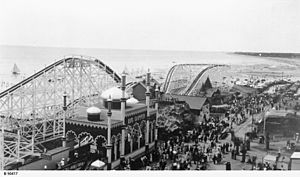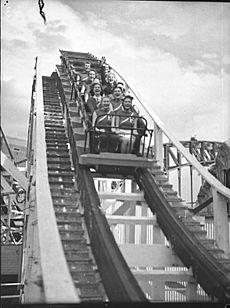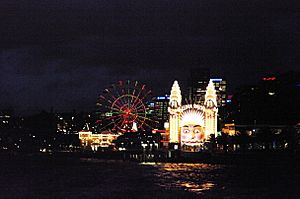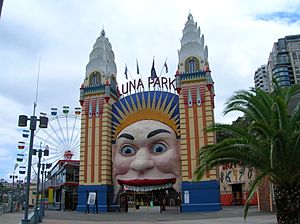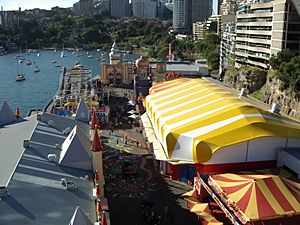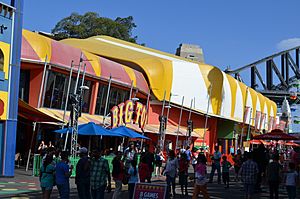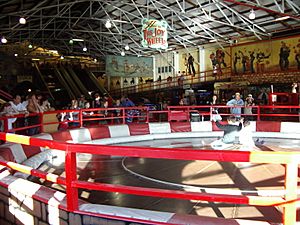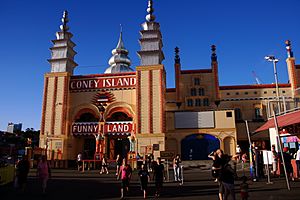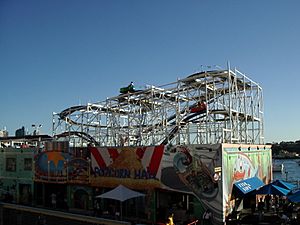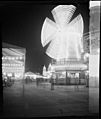Luna Park Sydney facts for kids
| Previously known as Sydney's Luna Park, Luna Park Milsons Point, Harbourside Amusement Park | |
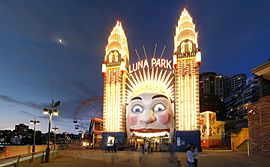
The Luna Park Face
|
|
| Location | 1 Olympic Drive, Milsons Point, New South Wales, Australia |
|---|---|
| Coordinates | 33°50′51″S 151°12′36″E / 33.8476°S 151.2100°E |
| Status | Operating |
| Opened | 4 October 1935 |
| Owner | Luna Park Reserve Trust |
| Slogan | Just For Fun! |
| Operating season | Year round |
| Attractions | |
| Total | 23 |
| Roller coasters | 4 |
| Luna Park Precinct | |
|---|---|
| Lua error in Module:Location_map at line 420: attempt to index field 'wikibase' (a nil value). | |
| Built | 1935– |
| Architect |
|
| Official name: Luna Park Precinct; Entrance Face and Towers; Crystal Palace; Coney Island; Alfred Street Entrance; Wild Mouse; Sandstone cliff; | |
| Type | State heritage (complex / group) |
| Designated | 5 March 2010 |
| Reference no. | 1811 |
| Type | Funfair |
| Category | Recreation and Entertainment |
| Builders |
|
Luna Park Sydney is a famous amusement park in Milsons Point, New South Wales, Australia. It sits right on the northern shore of Sydney Harbour. The park is owned by the Luna Park Reserve Trust, which is part of the Government of New South Wales. It was added to the New South Wales State Heritage Register in 2010 because of its special history and design.
The park was built in 1935, not far from the Sydney Harbour Bridge. It used to open for about seven months each year until 1972, when it started opening all year round. Luna Park closed in 1979 after a sad fire in the Ghost Train ride. After this, most of the park was taken down and a new one was built. It was first called Harbourside Amusement Park before going back to the Luna Park name. The park closed again in 1988 because some rides needed big repairs.
Luna Park reopened in 1995 but closed again after just over a year. This was because of noise from the Big Dipper rollercoaster. People living nearby complained, which limited the ride's hours and made the park lose money. After more changes, Luna Park reopened in 2004 and has been open ever since.
Luna Park is one of only two amusement parks in the world protected by special government laws. Many of its buildings are also listed as important historical sites. Old plans and drawings of the rides and buildings are kept at the State Library of New South Wales. The park has also been used as a place to film movies and TV shows.
Contents
History of Luna Park Sydney
How Luna Park Started
Before Luna Park, the area was used for building the Sydney Harbour Bridge. Once the bridge was finished in 1932, the local council looked for new ideas for the site. At the same time, three friends – Herman Phillips, David Atkins, and Ted "Hoppy" Hopkins – were looking for a new spot for their Luna Park, which was in Glenelg, South Australia. They had some problems with the local council there.
Herman Phillips won the bid for the Sydney site in March 1935. Soon after, the Luna Park in Glenelg closed. Its rides were bought by Phillips and his team. They took the rides apart, moved them to Sydney, and put them back together in just three months. This work cost a lot of money and involved almost 1,000 workers, including engineers and artists.
Early Years: 1930s to 1950s
Luna Park first opened on 4 October 1935 and was an instant hit. After its first successful season, the park would close for the winter months. This happened every year until 1972. During these closures, rides were fixed up and repainted. New rides were also added to make visitors feel like the park was always fresh and new.
During World War II, Luna Park was a popular place for soldiers and their dates. The park's outside lights were dimmed in case of a Japanese attack on Sydney. Neon lights were turned off, and less important uses of electricity were stopped.
In the early 1950s, many changes came to Luna Park. Atkins and Hopkins traveled the world, bringing back ideas for new rides from other amusement parks. The Rotor ride was built and became known for amazing stunts. Arthur Barton, a famous artist, redesigned the huge face over the park's entrance, which had started to look old. This new design was based on "Old King Cole" and is similar to the face you see today.
Changes from the 1950s to 1970s
In the late 1950s and early 1960s, more people had televisions and cars. This meant they had more choices for entertainment. Even with efforts to keep people interested, like adding the Wild Mouse ride, the park was sold in 1969.
A new group bought the park. The last of the original park creators, Hoppy and Barton, retired in 1970. The new owners wanted to build a big trade center on the site, but the Government of New South Wales said no. So, they decided to keep running it as an amusement park.
Over the next few years, the new managers removed some old rides and put in new, exciting ones. The park's slogan changed for a while to "The Place where Happiness is." In 1972, the park started opening all year round, meaning no more winter breaks for ride overhauls.
In April 1979, 13 people were hurt on the Big Dipper. A part of the track came loose, causing one rollercoaster train to stop and another to crash into it.
The Ghost Train Fire and Rebuilding
On 9 June 1979, the park's Ghost Train ride caught fire. The fire quickly destroyed the ride. Sadly, six children and one adult died. The park was immediately closed. An investigation could not find out what caused the fire. It did say that the park's managers had not done enough to keep visitors safe.
The NSW government looked for new owners for the park. Many people wanted to save Luna Park. A group called "Friends of Luna Park" organized a protest march and a free concert. This helped get the Luna Park Face listed as an important national heritage item.
Harbourside Amusement Park
A company called Australian Amusements Associates took over the park in 1981. They sold off everything that could be moved. Then, almost everything that was left (except the Face, Crystal Palace, and Coney Island) was knocked down and burned. The park was rebuilt with new designs.
The park reopened in April 1982 as Harbourside Amusement Park. It ran until 1988. During this time, the Face was moved twice. The park closed again in April 1988 because engineers said several rides needed urgent repairs.
By 1989, no repairs had been made. The government told the owners to reopen Luna Park by June 1990 or lose their lease. When they didn't, the government took back the park. The "Luna Park Site Act 1990" was passed to protect the park's land for fun and public use. This made Luna Park one of only two amusement parks in the world protected by government law. The other is Denmark's Tivoli Gardens.
Luna Park's Comeback
In 1991, plans to fix up Luna Park were approved. Work began in January 1993, and the famous Face was put back over the entrance. Many skilled workers helped restore the park's buildings and artworks.
Some people living nearby were worried about noise from the park, especially from a new, tall roller coaster called the Big Dipper. The government allowed the Big Dipper to be built but said the park had to control noise and pay for soundproofing if needed. The local council also set times when the roller coaster could not run.
Luna Park reopened in January 1995. However, bad weather and legal issues from some residents caused problems. The park closed again on 14 February 1996.
New Management and Reopening
Even though the park was closed, many people wanted it to reopen. High school students even collected 5,000 signatures on a petition! In 1997, the government showed four ideas for the park's future. A plan that included rides, restaurants, and event spaces was chosen.
In 1999, Metro Edgley Group won the bid to run the park. Their plan was to keep most rides but replace the Big Dipper with a concert venue. They also wanted to make Crystal Palace into an event center. It took a long time to get all the approvals, but work finally started in 2003.
During this time, Luna Park was allowed to open for special charity events and on some weekends.
2004 Reopening to Today
The park was rebuilt and restored over 14 months. Rides were fixed up to meet modern safety rules. Crystal Palace was redesigned for events, and a new 2,000-seat concert hall called the Big Top was built. Luna Park reopened on 4 April 2004. Even with rain, thousands of people came on opening day.
Some residents tried to take legal action again in 2005, complaining about noise from rides. However, new laws were passed to protect Luna Park from such claims. Another case started in 2007, but it was dismissed by the court in 2009.
In 2007, a staff member was hurt by a ride called Speed. Also, the company running the park tried to sell some undeveloped land, which caused concerns about how the money would be used.
In 2011, the NSW government gave money to upgrade the park's lights to modern LEDs and fix some buildings.
Exploring Luna Park
The Face
The huge, smiling face at the entrance of Luna Park is famous! It's about 9 meters wide and has been there for almost all of the park's history. There have been eight different faces since 1935. The current face, built in 1994, looks like the "Old King Cole" design from 1950.
The Midway
The Midway is the main path through Luna Park. It starts at the Face and leads to Coney Island. It's where you'll find many activities, games, and most of the park's rides. It also gives you access to the Crystal Palace and the Big Top.
Crystal Palace
The Crystal Palace started in 1935 as a place for dodgem cars and offices. Over the years, it has been a dance hall, a BMX track, and even a games arcade.
Since 2004, the Crystal Palace is used for events and parties. The main room on the ground floor is often used for weddings. Outside, facing the Midway, you can play classic carnival games like Laughing Clowns.
The Big Top
Built in 2003 where the old Ghost Train used to be, the Big Top is a large, modern venue. It can hold 2,000 people for seated shows or 3,000 for standing concerts. Its design allows it to be changed easily for different events. The building is also soundproofed to keep noise from bothering neighbors. The Big Top hosts concerts, award shows, sports events, and trade shows.
Coney Island
First built in 1935, Coney Island is the only original 1930s funhouse still working in the world! Its layout is almost the same as when the park opened. It has spinning barrels, moving floors, big slides, and arcade games. Today, Coney Island also shows off restored artworks and photos from Luna Park's history. The slides and games are the same ones from 1935, but they've been updated to be safe. These fun attractions were saved from being destroyed in 1981 by a group called 'Friends of Luna Park'.
Maloney's Corner
This area is named after Tony Maloney, a long-time Luna Park worker. Maloney's Corner was built on land bought in 1994 to help support the Big Dipper roller coaster.
Rides at Luna Park
Current Rides to Enjoy
Here are some of the rides you can enjoy at Luna Park today:
- Hair Raiser - This is a 50-meter tall drop tower added in 2013. It lifts you high up and then drops you fast!
- Wild Mouse - This Wild Mouse roller coaster was first put in the park in 1962. It's been taken apart and moved a few times, but it always comes back! It's one of only two left in the world.
- Ferris Wheel - This 35-meter tall Ferris wheel has 24 gondolas and was added in 1982. It gives great views of Sydney Harbour.
- Rotor - Luna Park's Rotor first opened in 1951. It was very popular. A slightly smaller version was built in 1995.
- Carousel - A classic carousel ride.
- Dodgem City - This is a hall with 18 dodgem cars. It's the latest in a series of dodgem car tracks at the park.
- 2nd Tango Train - This ride reopened in 2016.
- Kids' Rides - Luna Park also has four rides just for younger children:
- Whirly Wheel - A smaller Ferris wheel.
- Magic Castle
- Space Shuttle
- U-Drive - A 'train' of cars that go around a small track.
Past Rides of Note
- Big Dipper I - A wooden roller coaster from 1930. It ran from 1935 to 1981 before being taken down.
- Ghost Train - This ghost train operated from 1935 until it tragically burned down in 1979.
- Big Dipper II - A steel roller coaster built in 1994. Noise complaints led to its closure in 1995. It was later moved to another park.
- Tumblebug - This ride was installed in 1995 and was the only one of its kind in Australia.
- Tango Train I - A Music Express ride that closed in 2016.
- Flying Saucer - This ride closed in 2013.
- Moon Ranger - The only HUSS Ranger ride in Australia.
- Spider - A HUSS Breakdance ride installed in 1995.
Luna Park in Movies and TV
Luna Park Sydney has been a popular spot for filming movies and TV shows. In 1959, the whole park was used for the movie Summer of the Seventeenth Doll. In the same decade, parts of the TV shows Six O'Clock Rock and Skippy the Bush Kangaroo were filmed there.
In 1976, characters from the TV show Number 96 visited the park. They were shown in Coney Island, eating fairy floss, and riding the Big Dipper.
Luna Park also appeared in two episodes of the 1989 show Betty's Bunch.
After the park closed in 1996, the Big Dipper was used for a scene in the movie Our Lips Are Sealed, starring Mary-Kate and Ashley Olsen. A documentary called Spirits of the Carnival - The Quest for Fun was also filmed about the history of Luna Parks, including the one in Sydney. After Luna Park reopened in 2004, scenes for the 2006 movie Candy were filmed in the Rotor ride. Luna Park was also featured in a few episodes of the Australian TV series Dance Academy.
The park also appeared in the music video for "Healing" by the K-pop group Seventeen, released in 2016. They filmed it when they visited Australia for their fan meeting.
Images for kids


